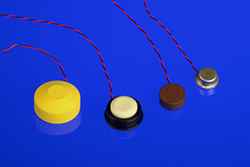Pushing the boundaries
Sensors are vital in a wide variety of level and metering applications as they allow the measurement of key attributes such as distance, flow, liquid level and volume. Charlie Dowling, Morgan Advanced Materials explains.
This is often delivered in highly challenging conditions which, depending on the sector and specific application, place specific requirements on the component. Requirements may include the ability to withstand shock and vibration, large temperature variations and even climatic phenomena such as lightning strikes - all without compromise to performance. When used in fuel and liquid handling technology, sensors must also be able to withstand permanent immersion in aggressive fluids. Other applications may require them to resist extreme pressures, placing great demands on the materials used and the toughness and durability of the units manufactured.
Traditional meters have typically been positive displacement products which operate via dynamic movement. While cost effective and utilised across a broad spectrum of applications, one potentially major issue is that they cannot distinguish between fluids and gases, causing severe measurement errors if any air is trapped in a system designed for fluids only.
Furthermore, their frictional method of operation can result in smaller particles breaking off from the sensor body and entering the fluid being processed, impacting drastically on accuracy measurements and contaminating the fluid, with potentially major costs.
A further issue arises with the need to operate at high temperatures. Historically the most common choice has been a Coriolis flow meter. The accuracy of these products is well documented, however this comes at a higher cost and a larger footprint than alternative technologies such as ultrasonic meters, creating major headaches for system designers.
The issues with traditional products resulted in the development of the first ultrasonic meters. Not only can ultrasonic products distinguish between fluids and gases - ensuring accurate measurement of flow - but the sensing option is solid state technology, eliminating all moving parts and preventing wear and associated maintenance costs.
PZT
The material most commonly selected for use in ultrasonic sensors in meters is lead zirconium titanate, usually known as PZT or piezoceramic. The key attribute of PZT is its marked piezoelectric effect - a reversible process whereby an applied mechanical force generates an electrical charge, while the application of an electrical field creates a mechanical strain.
Piezoceramic sensors are ideally suited for use in sectors such as oil and gas, aerospace, marine and chemical processing (above left), with modern material processing techniques now enabling the manufacture of products able to deliver continuous operation between -30°C and 160°C at pressures up to 200 bar.

Ultrasonic piezoceramic sensors are versatile enough to deliver extreme levels of accuracy with virtually all liquids and gases. Customisable solutions enable housings which suit chemically aggressive environments and other individual customer needs.
Sensor types benefiting from this temperature tolerant technology include flow measurement, continuous level sensing, distance detection and ‘contact’ sensors. As well as excellent functionality at high operational temperatures, modern sensors can tolerate wider non-operational temperature ranges and regular thermal cycling during service. Additional ultrasonic assessments can be made including the identification of fluid ‘quality’ and chemical concentration. This is particularly beneficial in the sensing of Adblue or diesel exhaust fluid - where fraud can be almost undetectable.
Above: ultrasonic piezoceramic sensors are versatile enough to deliver extreme levels of accuracy with virtually all liquids and gases.
Performance critical
One illustration of the performance levels being offered by ultrasonic sensors is in the field of motorsport. Sensor functionality here is crucial, as teams risk disqualification if they cannot efficiently balance performance and fuel consumption.
The requirement in this instance was for a fuel flow sensor able to provide accuracies of +/-0.25%, with the resulting component being an innovation offering unprecedented control over fuel consumption.
Designed to help promote energy efficiency in motorsport by measuring fuel flow as part of limiting total energy use, the sensor is appropriate for all categories of motor racing, including touring and rally cars, as it can accurately measure flow rates of +/-8,000ml per minute, across a temperature range of 0°C to 105°C. Weighing in at just 330g - far less than the 500g maximum weight permitted by the Fédération Internationale de l’Automobile (FIA) - the sensor provides accuracy without adding unnecessary weight to the vehicle.

The sensor is capable of operating in fluid pressures of 50kPa to 2,500kPa and an external pressure rating of 300kPa, making it well suited for harsh vehicle applications. Intelligent on-board electronics process volumetric flow values and compute a mass flow output. Manufactured from highly engineered materials including anodised aluminium alloy with stainless steel to form a compact and lightweight unit with no moving parts, the sensor is compatible with all fuel types and has the potential to impact on how everyday automobiles work today.
Further developments being planned in the field of PZT sensors include the introduction of products able to calculate temperature and density, a further testament to the versatility of this material.







